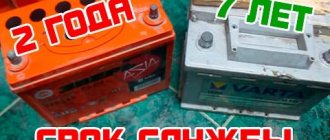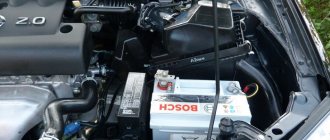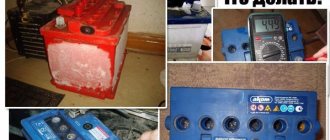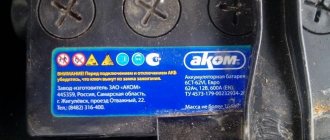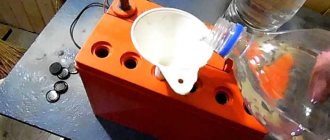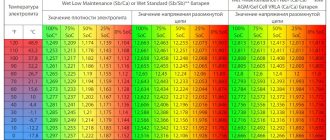If you do not monitor the electrolyte level, premature destruction of the battery plates begins. At the same time, you cannot overfill the water either - then the battery capacity drops, and in winter there is a risk of the electrolyte freezing.
You need to add distilled water to a level of 1.5-2 centimeters above the edge of the plates or 0.5 cm above the special indicator (“reeds”). The goal is to achieve a battery electrolyte density of 1.27 g/cm³ .
Do you know the correct level of electrolyte in the battery, how to determine it, how to maintain it at the required level, what to add and how to do it? No - then read the article.
How to add distilled water
To top up the water, distilled water is required. Raw tap water or boiled water is not suitable, because... contains impurities that negatively affect the course of chemical processes and can even worsen the condition of the battery, because impurities settle on the battery cells. Boiling does not remove hard impurities, salts and metals from water; boiling can only kill bacteria and microbes in the water.
The brand of distilled water you fill does not matter. The battery plugs are unscrewed and water is carefully added to the level marked on the monoblock. If the monoblock is not transparent, then add enough water to completely hide the electrodes, and the water supply on top is at least 1 cm.
After adding water, it is recommended to charge the battery on a charger. A fully charged battery will have a density of 1.26-1.28. If the density is significantly different, then something went wrong and you better contact a specialist.
How to add water to a maintenance-free battery without access to banks
In practice, without access to banks, maintenance-free batteries are made using calcium technology, i.e. which do not require topping up fluid throughout their entire service life. But it happens that when recharging, boiling still occurs. If there is no access to the battery, but you need to add fluid, you will have to suffer. It is recommended to drill small holes of 2-4 mm in the battery cover. and carefully add distilled water into them using a syringe.
What happens if you add electrolyte instead of water?
If you need to add distilled water to the battery, and you add electrolyte, then after charging the battery its density will exceed 1.30 and the sulfuric acid content will become prohibitive. This will lead to accelerated sulfation of the battery plates and failure. Batteries with increased density exist and are used in the far north to prevent ice from forming in the batteries, but the battery itself in this condition can last no more than 1 year.
From a pharmacy or an auto store - what and when to choose?
In fact, the distillate, both in a pharmacy and in a car dealership, is pure water with minor technical impurities. Medical products can be of two types - for injection (sterile) and for general use.
To manufacture the first modification, sterile devices are used, which naturally leads to an increase in the cost of the method and the final product. Therefore, you can buy it both at a car dealership and at a pharmacy. There is no difference between them in terms of applicability. The only thing you should pay attention to is the price tag of the product.
Find even more information about the points of sale of battery distillate at the link.
How do the properties of electrolyte change in a car battery?
To have an idea of what to add to a car battery, you need to understand the processes that occur inside the battery during the charging/discharging cycle. If you do not have an understanding of these processes, you may make a mistake that will lead to a change in the density of the liquid and failure of the battery.
The electrolyte of car batteries consists of 35% sulfuric acid and 65% distilled water. This ratio allows you to achieve values of 1.27-1.29 g/cm 3 - optimal for delivering the required voltage.
In what cases should electrolyte be added?
- Linear recharge. The reason is a faulty car charging system, as a result of which the electrolytic fluid boils. You can check the charging system with a multimeter. The charge level at idle and when overloading should not exceed 14.8 V. If you notice streaks on the case and oxidation on metal surfaces near the battery, after eliminating the cause of the malfunction, be sure to check the level and density of the electrolytic fluid. Prolonged operation of the battery while overcharging is dangerous because the plates are exposed, as a result of which they heat up and lose active mass, and a sulfation reaction occurs. You can see a dark coating on the inside of the plugs. It is better not to try to revive the battery by adding electrolyte, but to replace the battery.
- Electrolyte leakage from one of the cans due to damage to the housing. Cracks and chips most often occur due to mechanical damage or freezing of water inside the case in severe frost. If the damage is minor, the housing can be repaired. In this case, you should correctly determine the ratio of electrolyte and distilled water in the battery. If the battery was damaged before use, it is necessary to fill in the electrolyte with the same density that remained in the damaged jar. If the battery was used in a damaged state, add both electrolyte and water, equalizing the density of the damaged and adjacent sections.
- Loss of electrolyte due to the battery being overturned or tipped over.
- Commissioning of dry-charged batteries. This production technology has retained its relevance only for motorcycles. All car batteries are supplied ready for use.
Is it possible
| You can charge a maintenance-free battery outside the car. |
With the onset of winter, low temperatures thicken the lubricant in the engine, making it more difficult for the starter to spin it - more energy is wasted, and more starting current is required. And if your maintenance-free battery usually runs, say, half charged, and that was enough, then in winter, after one or two unsuccessful attempts to start the engine, the starter will simply stop turning. Charging a maintenance-free car battery is a must when winter sets in. It needs to be brought to a 100% charge level and then you can leave the garage more calmly.
In what cases should electrolyte be added to the battery?
When carrying out restoration measures, it is important not to cause additional damage to the battery. Incorrectly adding electrolyte or water can further disrupt the electrochemical balance and will ultimately destroy the battery. For example, when sulfating plates, acid is consumed from the solution; To replenish the volume, refilling with clean electrolyte is required. When water naturally evaporates, distillate must be poured into jars, since the introduction of additional sulfuric acid will cause accelerated sulfation.
The need to replenish the fluid supply in the battery is determined by the results of level measurement. Topping up pure electrolyte is possible if the owner knows exactly the volume of the lost substance. Otherwise, it is necessary to measure the density of the solution, which allows maintaining the optimal concentration of sulfuric acid.
Why does the battery need maintenance?
Electrolyte is a mixture of sulfuric acid and distilled water, which enters into a chemical reaction with the active mass of the negative and positive plates. When a lead-acid battery is discharged, sulfuric acid and water are consumed from the electrolytic fluid, resulting in a decrease in the density of the electrolyte. During the reverse process, when the battery is charged, the amount of lead on the electrodes can decrease so much that the process of water electrolysis begins to predominate inside the battery. The “boiling” described above occurs when the battery is recharged, and the release of hydrogen and oxygen gas results in an increase in the density of the electrolyte.
Overcharging is dangerous not only due to water boiling away, but also due to the explosion of gases formed inside the battery case. Therefore, you need to monitor the health of the car's charging system. If charging from an external device, you should unscrew the service plugs and set the charging current correctly.
The prepared material mainly relates to low-voltage lead-acid batteries (Sb/Sb). Batteries of this type are most widespread due to their low cost, but owners should remember the disadvantages: high self-discharge and a decrease in density due to boiling water. Some calcium batteries (Ca/Ca) also require scheduled maintenance, which the manufacturer must indicate in the operating instructions.
Features of servicing Mutlu, Bear, Beast 60 Ah and Varta devices
For ease of maintenance, Mutlu brand batteries are equipped with a charging and charging indicator.
The characteristic state of the device corresponds to its color:
If the color is yellow or white, refilling with distillate is required. It is entirely carried out according to the mechanism discussed above.
battery with a capacity of 60 Ah also has a charging indicator and electrolyte level with the following characteristics:
- Green – charged.
- White – low density, requires charging.
- Red – electrolyte refilling is required.
When the indicator color is red, it is necessary to top up the battery with distilled water according to the scheme discussed above.
Bear and Warta batteries are filled as standard. In addition, the manufacturer Varta has released a special refilling container that can be inserted into six cans at once.
What electrolyte level should be in the battery?
Modern starter batteries for cars are often manufactured in transparent cases, on the outside of which are marked the minimum and maximum fluid levels. This makes control much easier. The amount of electrolyte may decrease due to water evaporation.
It is strictly not recommended to replace the electrolyte, since it is very difficult to do. Firstly, the acid is inside the plates. Secondly, during operation the plates are subjected to heavy loads and therefore partially crumble. If the battery is turned over, there is a high probability of a short circuit.
To check the liquid level, glass or plastic tubes are used, which are included in the hydrometer kit.
Cleaning the battery and opening the filler holes
Before opening the plugs, clean the top of the battery from dirt and debris. For these purposes, you can use a rag soaked in window cleaner. A solution of soda will help remove rust from the terminals. After all these procedures, the battery must be wiped dry. The best option is to keep the battery clean. In this case, it is better to coat the terminals with a protective lubricant.
The design of the filler caps may differ between different battery models. Some of them have all six plugs located under one common strip, which is easily removed. Others require you to unscrew each of them counterclockwise. Dirt under the plugs should be removed using a detergent containing ammonia. Under no circumstances should soda be used to clean the filler holes.
Electrolyte level determination
The normal level of battery fluid is 10-15 mm above the plates. If for some reason this layer decreases, then you need to add distilled water. Excess liquid should be carefully removed using a hydrometer. Some maintenance-free battery models are equipped with special charge indicators that also show the electrolyte level. If the “eye” turns white, the battery needs to be changed.
Checking the density and electrolyte level in the battery
Special glass tubes are used to measure the level. If they are not there, then you can use the body of a transparent handle by cutting off its tapered end. To take measurements, you need to unscrew the filler plugs and insert a tube into them vertically one at a time, hold the opposite end with your finger and pull it out.
How to recharge the battery?
Before you start deciding whether to add water or electrolyte to the battery, it is important to decide whether the mechanism needs to be refilled at all. For this purpose, you need to carefully inspect your existing unit. Mostly, the housing of all batteries is made of transparent plastic, which allows you to visually determine the amount of electrolytic solution inside. There are almost always marks on the battery case, by which you can determine whether the emulsion needs to be topped up or not.
If the housing is made of opaque material, you can check the emulsion level in the following way:
- Unscrew the battery cap. Thoroughly clean the front surface of the unit first so that when opening it, no dirt particles get into the system.
- Take a transparent tube with a diameter of no more than five millimeters and lower it all the way into the opening.
- Close the outer end of the tube tightly with your finger and pull the device out of the system without releasing your finger.
- The criteria are considered normal when the height of the liquid in the elongated tube is approximately one and a half centimeters. If the parameters do not match, it is necessary to top up or remove excess liquid.
If the need for topping up has been established, then you need to decide what needs to be added to the battery. A special device called a “hydrometer”, which can be used to measure the density of the solution in the battery, can help in this situation. Based on the test results, the cause of the mechanism malfunction is determined, and the dilemma of whether to add water or electrolyte to the battery is resolved. Using the device, measure the density of the battery fluid: normally it should be from 1.27 to 1.29 grams per cubic centimeter. If the density is significantly lower, then an electrolyte will need to be added. A density exceeding 1.29 units indicates that water must be added to the battery.
How do the properties of electrolyte change in a vehicle battery?
Many professionals consider the question of what to put in the battery to be absolutely incorrect, since the device is classified as a non-repairable element. However, a good battery is far from a cheap pleasure, so the desire of car owners to extend its service life is understandable. To ensure that refilling the battery does not lead to its complete failure, you first need to understand the processes that occur during the operation of the battery during its systematic charging and discharging.
Initially, from the factory, the battery contains an emulsion, which consists of thirty-five percent sulfuric acid, while the remaining sixty-five percent of the volume is distillate - purified water, without impurities. During operation, the device heats up, an electrolysis reaction occurs, and part of the water evaporates under the influence of high temperature and collects as condensate on the inner surface of the unit. If the battery has a completely sealed design and there is no mechanical damage in the case, then when it cools, the steam turns into water and flows back down the walls of the device. If there is damage to the case as a result of operation of the device or due to poor manufacturing quality of the product, the water evaporates from the battery irretrievably. As a result of this process, the liquid in the battery becomes more concentrated, and the density of the acid increases. This is reflected in the voltage output criteria of the device and its performance.
In addition to the natural process of evaporation at operating temperatures, the so-called sulfation reaction occurs in the battery - the deposition of acid salts on the lead strips of the battery. As a result of this process, the electrolyte concentration decreases. Precedents when the density of the electrolyte drops are most often provoked by irregular functioning of the battery as a result of prolonged downtime of the car or incorrect operation of the battery - supplying too much current to the device or serious malfunctions in the vehicle electronics.
When should you add electrolyte?
The electrolyte in the battery is necessary for the proper operation of the electrode plates, which accumulate and subsequently release charge.
Over time, due to high temperatures and boiling of the electrolyte, a drop in the liquid level may be observed, which negatively affects the condition of the battery.
If the car owner does not monitor the fluid level in the battery banks, this leads to the plates being exposed, their active sulfation begins , and soon such a battery will completely fail.
Where can I get special liquid?
The modern car owner has a choice of many sources where he can buy distillate:
In a specialized auto parts store.- In the household department of a supermarket.
- At a chemical retail outlet.
- At the pharmacy.
- In the sales pavilion at the gas station.
- At the service station.
- In the online store.
How to determine the required quantity for a battery?
You can understand how much is needed to replenish the mixture with electrolyte (provided that this is what is needed) or distilled water (in a similar case) in the following ways.
All measurements must be carried out with a fully charged battery.
Visually
The manufacturer applies special “risks” min – max to the battery case. It is by the marks on the battery that you can navigate how much is required (and what exactly) to add to the mixture. When filling, you must ensure that the required amount is added above the minimum mark, but below the maximum.
If there are no marks on the body, then you need to add so that the metal plates are covered by 1-1.5 cm.
Instrumentally
There are special measuring tubes with which you can measure the level of the electrolytic mixture.
If you don’t have a device, you can use any glass or plastic rod. A stick 20-25 cm long and 5-7 mm thick is suitable.
Having opened all the cans, you need to measure the level in each one individually. To do this, lower the tube all the way and lift it up. It will clearly show how much mixture is in the battery jar.
You need to add until the level reaches a height of 1.5-2.0 cm. If distilled water is added to the required level, the density of the electrolytic mixture will be restored to its original parameters of 1.27 g/cm3.
This is necessary to ensure full operation of the battery. Attention! Topping up maintenance-free batteries is not provided by the manufacturer!
Access to the banks is strictly limited by the complete sealing of the housing. The video provides detailed information on how to measure the electrolyte level in a battery:
Charging after topping up
After the electrolyte level is brought to the desired mark, the battery should be left for 3-4 hours for better mixing of the components.
Then you can put it on charge, following the algorithm:
- With the covers open, connect the charger to the terminals, observing the polarity, and plug it into the mains.
- The current strength should not exceed more than 10% of the battery capacity.
- If the electrolyte begins to boil before the desired density is established, you should turn off the charger and allow it to cool. You can also reduce the current.
- Charging is considered complete when the density value reaches the specified value when heated to 25-30 0 C.
- After completing the procedure, after half an hour, bring the electrolyte level to normal with distilled water, close the plugs and install for operation.
Read a detailed article about charging the battery after topping up here.
Proper battery maintenance
Currently, the industry mainly produces low-maintenance batteries for cars; they require a minimum of care, however, preventive maintenance must be carried out regularly. To service the battery, you must:
- Remove the battery from the car:
- take it to a warm room;
- clean the housing from dirt and salt deposits (do not turn the housing over);
- clean the terminals from deposits with sandpaper; if they are oxidized, wipe dry with a clean rag;
- let it sit for 10-12 hours (you can do it for a day; it is especially important to let the battery “dead” in winter).
Then you should check the electrolyte level in the jars, add distilled water if necessary, and charge the battery. You can’t do without a charger, just like you can’t do without a hydrometer, and it would also be nice to have a multimeter and a load plug. After the battery has settled, we check the voltage without load with a multimeter; it should be in the range of 12.4-12.7 Volts. When connected to the terminals of the load plug, the voltage should not fall below 9.6 V, the load lasts about 5 seconds.
After adding water to the required level, we check the density with a hydrometer; in those jars where we had to add more, the density will be lower accordingly. Then we place the plugs in their places without tightening them, connect the charger to the terminals, if the battery is in fairly good condition, automatic mode is suitable for charging.
The battery is charged most efficiently at room temperature +20ºC; after charging, it is again necessary to let the battery sit, but 5-7 hours is enough. Then we repeat all the checks again, the most optimal values are:
- voltage without load – 12.7 Volts (up to 13.0 V);
- under load – from 9.6 to 10.4 V;
- density – 1.27-1.28 g/cm³.
For northern regions, the electrolyte density can be set higher (up to a value of 1.31); for southern regions, 1.26 g/cm³ is often sufficient. Depending on the type of battery, it is recommended to carry out battery maintenance once or twice a year; low-antimony batteries require maintenance more often, approximately once every 3 months.
Many novice motorists have a question about how to add distilled water to the battery if it is from the category of serviceable batteries. Accordingly, the second question arises, how much liquid needs to be added and whether this can be done independently at home.
A guide to restoring equipment using distillate
Over time, the amount of lead sulfate deposited on the plates becomes so large that the battery completely loses its original properties.
The only way to revive it from this state is to carry out desulfation, that is, to remove these salts.
There are several ways:
- Mechanical.
- Chemical.
- Electrochemical.
The first option involves disassembling the case, removing the plates, and then mechanically manually cleaning them from salts.
The second uses a lead sulfate corrosive agent. However, the effectiveness of both methods is quite questionable, since as a result the battery may become unusable.
The third method is the most optimal. It uses a special charger with a desulfation function.
Its application is quite simple:
- Connect the battery filled with distilled water to the charger.
- Plug in and monitor the display indicators.
Electrolyte to water ratio
To obtain 1 liter of electrolytic fluid with a density of 1.27-1.28, mix 0.772 liters of correction electrolyte and 0.295 liters of distilled water. During normal operation, only water evaporates, so you cannot add electrolyte instead of distillate. To avoid mistakes with the density, maintenance is carried out only after the battery is fully charged.
Overflow of water, at which the density drops to the level of 1.26, is considered uncritical. When this limit is lowered, it is already necessary to pump out part of the liquid, bring the density to the factory value, adding correction electrolyte.
Fluid overflow - what is it and what to do if it happens?
This means that when filling the container, the electrolyte level rose above the set level. In this case, it is necessary to cast it to the required level and put it on charge.
After a complete cycle, the density should be measured. If it is in order, there is nothing to worry about, and the battery can be put into operation. In the worst case, its value may decrease, then the electrolyte will need to be completely replaced.
More details on the issue of overflow can be found here.
About flushing
We noted earlier that when taking measurements, an opaque liquid can be detected. This indicates that the solution contains destroyed particles of lead plates. If you restore the battery, they must be completely removed. What to put in the battery? First you need to use distilled water. Fill all damaged jars with it, close the lid and mix thoroughly. Don't be afraid to turn the battery upside down.
This way we can better clean the insides of the jar from dirt. After mixing, pour back all the dirt. What should I put into the battery next? Let's use water again. We already know how to fill the battery with water. If after repeated mixing it does not change color, it means that we have removed all the dirt from the plates. Now you can safely pour electrolyte here and measure the density. By adjusting the water and electrolyte levels we will reach the ideal value of 1.28 grams per cubic centimeter.

